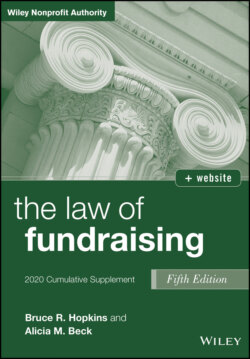Читать книгу The Law of Fundraising - Bruce R. Hopkins - Страница 16
На сайте Литреса книга снята с продажи.
ОглавлениеCHAPTER THREE States' Charitable Solicitation Acts
1 § 3.2 Definitions (a) Charitable
2 § 3.4 Annual Reporting
3 § 3.20 Miscellaneous Provisions
4 *§ 3.22 Unified Registration
§ 3.2 DEFINITIONS
(a) Charitable
p. 52. Insert as fourth complete paragraph, before heading:
There is authority for the proposition that the term charitable is, in the context of solicitation, a word of “common understanding” that an individual of ordinary intelligence can discern.9.1 That position must surely be the minority one, not sustainable in relation to the varied uses of the word in the states' charitable solicitation acts.
§ 3.4 ANNUAL REPORTING
p. 64, third paragraph, third sentence. Insert footnote at end of sentence:
45.1For charities subject to this requirement, the annual information return is likely to be a Form 990 or Form 990‐EZ (see § 6.1(a)). These returns include schedules, including Schedule B, which is a list of significant donors (see § 6.11). Schedule B is not a public document for federal law purposes. States that require a copy of the federal return, however, are likely to want an unredacted copy of the schedule. Litigation in this regard is ongoing (see § 6.11(b)) and the subject of much commentary (see § 8.12(a)).
§ 3.20 MISCELLANEOUS PROVISIONS
p. 85. Insert as first paragraph:
Beginning July 1, 2014, organizations registered to solicit contributions in Florida are required to adopt a conflict‐of‐interest policy. This policy must require annual certification of compliance with the policy by all directors, officers, and trustees of the organization, and a copy of the annual certification must be submitted to the Department of Agriculture and Consumer Services as part of the annual registration.
*§ 3.22 UNIFIED REGISTRATION
pp. 85–86. Replace existing section with:
The National Association of State Charities Officials (NASCO) and the National Association of Attorneys General (NAAG) have developed a project to standardize, simplify, and economize the process of registration pursuant to the states' charitable solicitation laws. This project is manifested in the Unified Registration Statement (URS). The URS is part of a larger effort by these organizations to consolidate the information and data requirements of all states requiring registration by charitable organizations engaged in fundraising. The initial URS effort consisted of three phases: (1) compilation of an inventory of registration information demands from all of the states, (2) production of a format (or form) that incorporates all or most of these demands, and (3) encouragement of the states to accept this standardized format as an alternative to their own forms.
There have been significant advances with the URS over the past few years. In 2014, NASCO introduced the idea for a single portal filing, known as the “Single Portal Initiative.” NASCO's objective was to create a single website for domestic charities to submit registration forms and financial reports to the states that require charities to register. Since then, the idea has become a reality. The official State Charity Registration Portal is available online at http://www.statecharityregistration.org/. As of the publication date of this supplement, the soft launch for the portal is live in Connecticut and Georgia.
On October 1–3, 2018, NAAG and NASCO convened in Baltimore, Maryland, for their annual conference. Topics included Ethics and Professional Conduct, Tax Reform, Oversight of Charities, and Developments in Governance. The conference also included a live demonstration of the Single Portal Initiative.
The URS project addresses registration only. Once registered, even under this uniform approach, a fundraising charitable organization is on its own in connection with annual reporting. Nonetheless, a project is under way to produce a format for annual reporting with states in the fundraising context.
NOTE
1 9.1 Gospel Missions of America v. City of Los Angeles, 419 F.3d 1042, 1048–1049 (9th Cir. 2005); Ryan v. World Church of the Creator, 760 N.E.2d 953, 962 (Ill. 2001).
